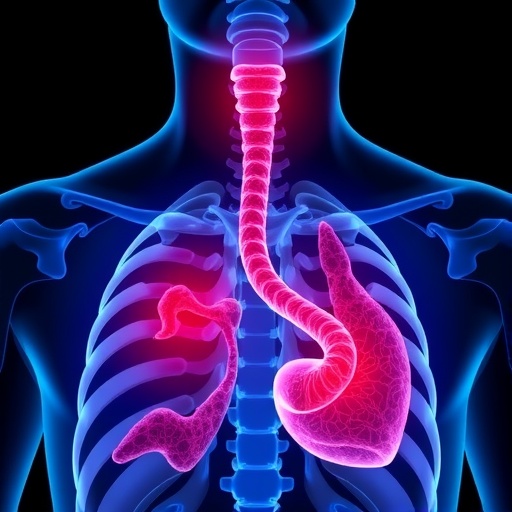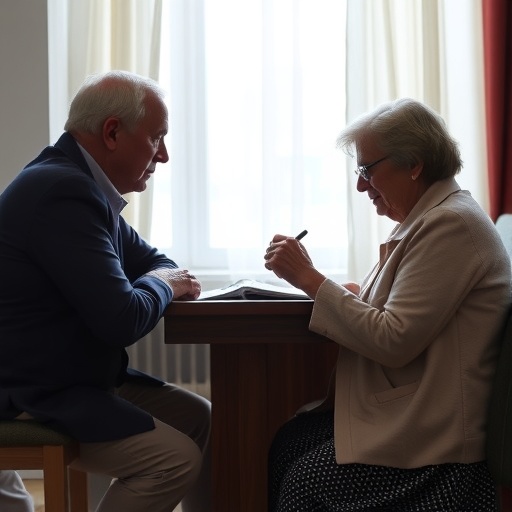In the ever-evolving landscape of oncology, breakthroughs in treatment strategies provide glimmers of hope for patients grappling with aggressive malignancies. A pioneering clinical trial led by researchers Peng, Wu, Lian, and colleagues has now unveiled a promising combination therapy for patients with unresectable locally advanced esophageal squamous cell carcinoma (ESCC). This malignancy, notorious for its poor prognosis and limited treatment options, has long posed a formidable challenge to oncologists. The study, recently published in Nature Communications, evaluates the efficacy and safety of induction chemotherapy coupled with camrelizumab—a PD-1 inhibitor—followed by an intensive regimen of concurrent chemoradiotherapy (cCRT). This novel sequencing of treatments may herald a new era in esophageal cancer management.
Esophageal squamous cell carcinoma remains a significant health burden worldwide, especially in East Asia, where its incidence is particularly high. The standard care for patients with unresectable locally advanced ESCC usually involves concurrent chemoradiotherapy, which combines radiation with chemotherapy to maximize local tumor control. However, despite aggressive treatment, survival rates remain dismal, and the high recurrence rates underscore the urgent need for therapeutic innovation. Immunotherapy, especially immune checkpoint inhibitors targeting the PD-1/PD-L1 axis, has revolutionized treatment paradigms across multiple cancer types. Yet, their integration into esophageal cancer treatment has been relatively nascent and met with cautious optimism.
The trial spearheaded by Peng and colleagues adopts a strategic approach by administering induction chemotherapy combined with camrelizumab prior to the conventional cCRT regimen. Induction chemotherapy aims to reduce the tumor burden and potentially sensitize the cancer cells to subsequent therapies. Meanwhile, camrelizumab, by inhibiting the programmed death-1 (PD-1) receptor on T-cells, unleashes the immune system to recognize and attack tumor cells, thereby enhancing antitumor activity. The interplay between chemotherapy-induced immunogenic cell death and checkpoint inhibition could synergistically potentiate tumor regression and improve clinical outcomes.
In this single-arm phase II study, the investigators enrolled patients with confirmed unresectable locally advanced ESCC. The treatment protocol commenced with induction chemotherapy alongside camrelizumab administration, followed systematically by concurrent chemoradiotherapy to the esophageal tumor and regional lymph nodes. The primary endpoints centered on safety, tolerability, and objective response rates, while secondary endpoints encompassed progression-free survival and overall survival metrics. This meticulous design aimed to delineate both the efficacy and side-effect profile of the sequential combination regimen.
Preliminary results from the trial were striking. Patients demonstrated a remarkable objective response rate after the induction phase, with significant tumor shrinkage observed prior to chemoradiotherapy. The subsequent cCRT, empowered by the primed immune milieu, further consolidated tumor control. Importantly, the safety profile was manageable; adverse events were consistent with known toxicities of chemotherapy, radiotherapy, and immune checkpoint inhibition, without unexpected synergistic toxicities. Such findings suggest that the treatment sequence is not only effective but can also be delivered safely in this fragile patient population.
The biological rationale underpinning this approach lies in the enhanced immunogenicity of tumor cells following cytotoxic chemotherapy. Chemotherapy can induce immunogenic cell death, releasing tumor-associated antigens and promoting dendritic cell maturation. This creates an environment ripe for immune checkpoint blockade to reinvigorate exhausted T-cells, facilitating a durable antitumor immune response. Radiotherapy may further amplify this effect by increasing antigen presentation and altering the tumor microenvironment. Thus, this multi-modality regimen leverages both direct cytotoxicity and immune modulation in a concerted fashion.
Against the backdrop of previous efforts which primarily focused on either immunotherapy or chemoradiation alone, this trial exemplifies the power of combinatorial strategies in oncology. Historically, esophageal cancer patients with unresectable disease have faced limited salvage options and poor survival outcomes. By pioneering the sequential use of induction chemoimmunotherapy followed by cCRT, this study charts a promising path forward. Moreover, the trial’s findings align with growing evidence across other cancer types that frontloading immunotherapy can optimize responses and minimize resistance.
Another compelling aspect of this study is the potential for long-term survival benefit. While the reported follow-up period remains relatively short, early indications suggest that patients achieving deeper responses during the induction phase may also experience improved progression-free intervals and overall survival. This underscores the criticality of early tumor debulking combined with immune priming. Future longitudinal follow-ups will be pivotal to ascertain whether this combination translates into durable remission and alters the natural history of ESCC.
The management of treatment-related adverse events was a crucial dimension of the trial. Immune-related side effects (irAEs), commonly seen with PD-1 inhibitors, were carefully monitored. Although some patients experienced mild to moderate irAEs such as dermatitis, thyroid dysfunction, and pneumonitis, these were effectively managed with steroids or treatment interruption. Concurrently, hematologic toxicities linked to chemotherapy and radiation were expected but did not appreciably compromise treatment delivery. This balance between efficacy and tolerability bodes well for broader clinical implementation.
The translational implications of this study extend beyond immediate clinical practice. It highlights the importance of understanding tumor-immune interactions and the temporal sequencing of multimodal therapies. The induction phase serves as an immunologic primer, potentially modulating the tumor microenvironment to enhance lymphocyte infiltration and functional activation at the time of radiotherapy. This paradigm shift could catalyze new trials investigating induction or neoadjuvant immunochemotherapy across other difficult-to-treat solid tumors.
Questions remain, of course, including optimal patient selection, biomarker development, and long-term survivorship data. The study hints at potential predictive markers such as PD-L1 expression and tumor mutational burden that could refine therapy personalization. Moreover, larger randomized controlled trials will be necessary to confirm these encouraging phase II results and to compare head-to-head with standard cCRT protocols. Nevertheless, the trial’s findings represent an exciting leap forward in esophageal cancer therapeutics.
In the context of global cancer research, this study reinforces the burgeoning role of immune checkpoint inhibitors in combination with established modalities. Camrelizumab, a PD-1 antibody developed with distinctive immunologic properties, demonstrates not only antitumor efficacy but also an acceptable safety profile in this setting. Its integration into multimodal treatment reflects a mature understanding of harnessing immune responses strategically alongside cytotoxic therapies, a concept increasingly embraced across oncology.
For patients battling unresectable locally advanced ESCC, the combination of induction chemotherapy, camrelizumab, and cCRT offers renewed hope. This regimen has the potential to extend survival, improve quality of life, and set new standards of care. By pushing the boundaries of current treatment algorithms, this trial epitomizes precision oncology’s promise: utilizing a rational, biologically informed approach to tackle some of the most aggressive cancers with innovative therapeutic combinations.
Ultimately, the work by Peng and colleagues exemplifies the dynamic integration of immunotherapy into multimodal cancer care, driven by rigorous clinical investigation and a sophisticated grasp of tumor biology. As the oncology community eagerly awaits further validation, this trial stands as a beacon of progress—a testament to the power of combining cytotoxic and immune-based strategies to conquer historically refractory cancers. The future of esophageal squamous cell carcinoma treatment may well be transforming before our eyes.
Subject of Research: Treatment of unresectable locally advanced esophageal squamous cell carcinoma using a combination of induction chemotherapy, camrelizumab (PD-1 inhibitor), and concurrent chemoradiotherapy.
Article Title: Induction chemotherapy plus camrelizumab followed by concurrent chemoradiotherapy in unresectable locally advanced esophageal squamous cell carcinoma: a single-arm phase II trial.
Article References:
Peng, F., Wu, J., Lian, H. et al. Induction chemotherapy plus camrelizumab followed by concurrent chemoradiotherapy in unresectable locally advanced esophageal squamous cell carcinoma: a single-arm phase II trial. Nat Commun 16, 10292 (2025). https://doi.org/10.1038/s41467-025-65206-z
Image Credits: AI Generated
DOI: https://doi.org/10.1038/s41467-025-65206-z
Tags: camrelizumab esophageal cancer treatmentclinical trial esophageal squamous cell carcinomaconcurrent chemoradiotherapy innovationsEast Asia cancer incidencehealth burden of esophageal cancerimmunotherapy in oncologyimproving survival rates in ESCCinduction chemotherapy for ESCCnovel treatment strategies for cancerPD-1 inhibitor cancer therapytherapeutic innovation in esophageal malignanciesunresectable esophageal cancer management





